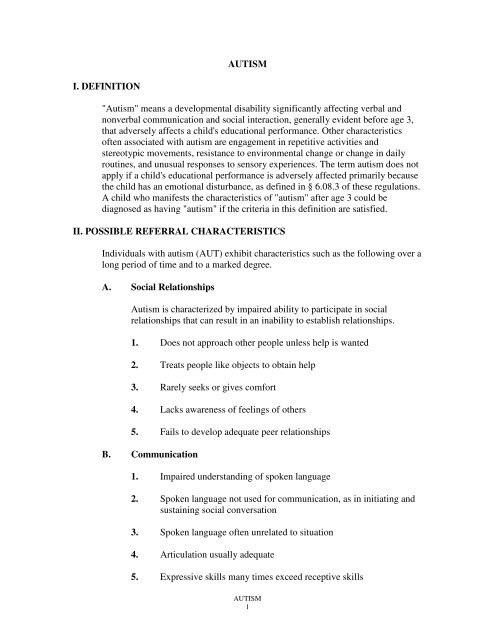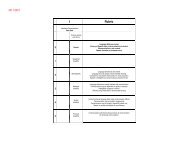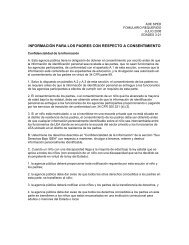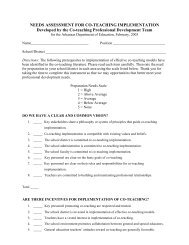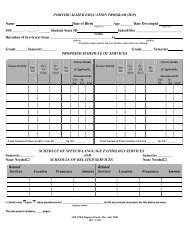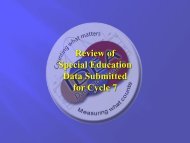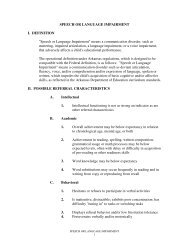Autism - ADE Special Education
Autism - ADE Special Education
Autism - ADE Special Education
Create successful ePaper yourself
Turn your PDF publications into a flip-book with our unique Google optimized e-Paper software.
AUTISMI. DEFINITION"<strong>Autism</strong>" means a developmental disability significantly affecting verbal andnonverbal communication and social interaction, generally evident before age 3,that adversely affects a child's educational performance. Other characteristicsoften associated with autism are engagement in repetitive activities andstereotypic movements, resistance to environmental change or change in dailyroutines, and unusual responses to sensory experiences. The term autism does notapply if a child's educational performance is adversely affected primarily becausethe child has an emotional disturbance, as defined in § 6.08.3 of these regulations.A child who manifests the characteristics of "autism" after age 3 could bediagnosed as having "autism" if the criteria in this definition are satisfied.II. POSSIBLE REFERRAL CHARACTERISTICSIndividuals with autism (AUT) exhibit characteristics such as the following over along period of time and to a marked degree.A. Social Relationships<strong>Autism</strong> is characterized by impaired ability to participate in socialrelationships that can result in an inability to establish relationships.1. Does not approach other people unless help is wanted2. Treats people like objects to obtain help3. Rarely seeks or gives comfort4. Lacks awareness of feelings of others5. Fails to develop adequate peer relationshipsB. Communication1. Impaired understanding of spoken language2. Spoken language not used for communication, as in initiating andsustaining social conversation3. Spoken language often unrelated to situation4. Articulation usually adequate5. Expressive skills many times exceed receptive skillsAUTISM1
6. May produce babble jargon, stereotypic or idiosyncratic language7. May appear deaf although hearing is normal8. May have abnormal pitch, stress, intonation, rate or rhythm ofspeechC. Behavior ProblemsA number of behavioral problems are associated with autism. Theseproblems could include tantrums, aggression, self-injury and propertydestruction. Serious behavioral problems can occur when establishedroutines or rituals are disrupted.D. Developmental Rates and Sequences1. Fine motor skills may be delayed2. Regression in motor skills may be present3. Play patterns lack variety and imaginationE. Cognitive/Conceptual1. Processes spatial, concrete information better than temporal,transient information2. Poor generalization or transfer of conceptsF. Visual Behaviors1. Close scrutiny of visual details2. Prolonged staring3. Over/under response to visual cues4. Lacks visual attention5. Poor eye/face regardG. Auditory Behaviors1. Non/over response to varying sounds; response to same sound maychange over time2. Seems not to hearAUTISM2
H. Tactile Behaviors1. Hypo/hyper response to touch and temperature2. Unusual response to pain stimuli3. Self-injurious behaviorsI. Olfactory Behaviors1. Smells objects/repetitive sniffing2. Licks inediblesJ. Vestibular Behaviors1. Over/under response to gravity stimuli2. Whirling without dizzinessK. Use of Objects1. May use objects inappropriately2. May become fascinated with parts of objects3. May engage in ritual behaviors (spinning, arrangement of objects,etc.)4. May form attachments to unusual objects such as sticks or stringL. Stereotypic Behaviors1. May engage in unusual body posturing, finger flicking and toewalking2. May use repetitive, stereotypic words and phrasesThe above examples are only a partial listing of possible referralcharacteristics and are not intended to provide an exhaustive list.III. SCREENING INFORMATIONA. Required1. Hearing2. VisionAUTISM3
B. Recommended1. Anecdotal records2. Basic skills inventories3. Systematic observation4. Sociometric techniquesIV. REQUIRED EVALUATION DATAA. Social History (Emphasis on developmental history)B. Individual Intelligence (One required)C. Individual Achievement (One required)D. Adaptive Behavior (One required)E. Communicative Abilities (Both receptive and expressive required)F. Other1. Observation (Required)Observation should cover personal-social behaviors, toy play,conversational speech, emotional expression, amount of time spentin idiosyncratic repetitive behaviors and eating behavior.Information can be obtained in a variety of settings includingobserving the child in the home environment, classroom and playsituations. The observed behaviors should be viewed in terms ofdevelopmental age so that formal assessment data andobservational data can be compared. Observational data must beconsidered part of the educational evaluation due to the impact ofbehavior upon skill acquisition.2. Medical (Required)a. Physical examinationb. <strong>Special</strong>ized, if indicatedV. OPTIONAL EVALUATION DATAA. Environmental InventoryAUTISM4
B. Functional Skills AssessmentC. Motor Development (Fine and gross motor)D. Vocational AssessmentVI. EVALUATION DATA ANALYSISAccurate diagnosis of autism may be difficult because the characteristics of thisdisorder may resemble those of mental retardation, severe reactive disturbances ordeafness. The determination of autism is also made difficult by the variety ofsymptoms and the rarity of the conditions exhibited by children with autism, aswell as the overlap of autistic behaviors with other cognitive and behavioraldisorders. Therefore, it is important to collect data from all areas specified in theevaluation section. Observational data and an account of the child's pattern ofbehavior from infancy to childhood will provide some of the most useful data forprogramming. Some common misconceptions regarding individuals with autismare as follows: autism is an emotional disorder; persons with autism do not talk;persons with autism do not communicate; persons with autism require one-to-oneinstruction; all persons with autism are withdrawn and most persons with autismare self-injurious.VII. PROGRAMMING CONSIDERATIONSA promising treatment for autism involves intensive educational programmingdesigned to meet the student's individual needs in the areas of language, socialskills, and self-control.A developmental framework provides a means to describe and understand thecharacteristics of an uneven learning pattern manifested by students with autism.However, appropriate programming, based on individual functioning levels andneeds, is of prime importance. Research has established that the most beneficialtreatment for students with autism is a highly structured and purposefuleducational program.The following are possible programming considerations:A. Heterogeneous GroupingB. Functional CurriculumC. Age-appropriate Tasks and MaterialsD. Instruction to Address Communication and Interaction DeficitsE. Systematic Intervention for Social/Communicative DevelopmentAUTISM5


